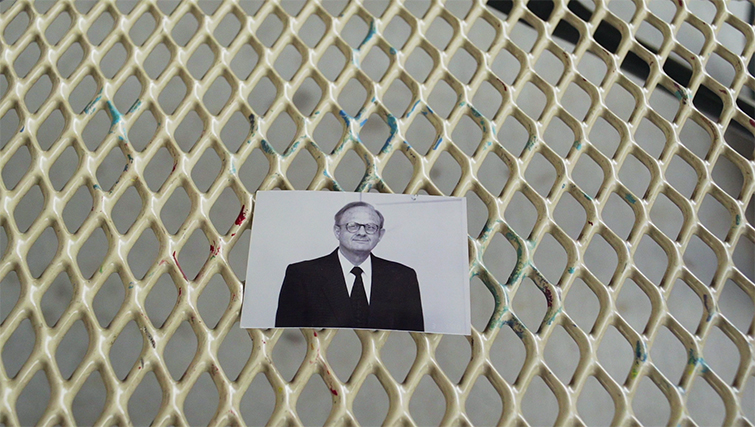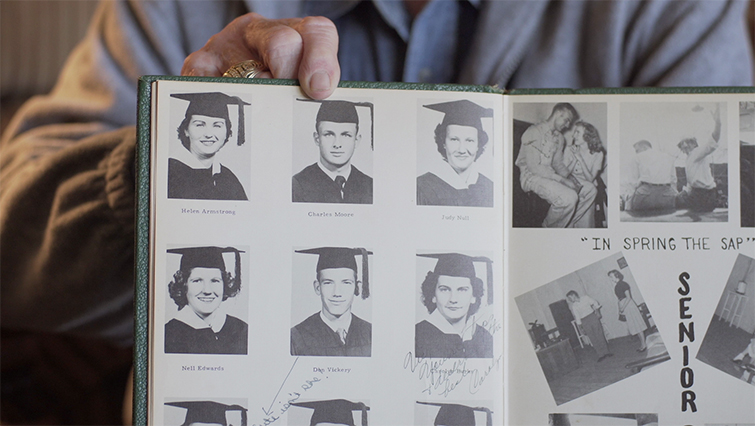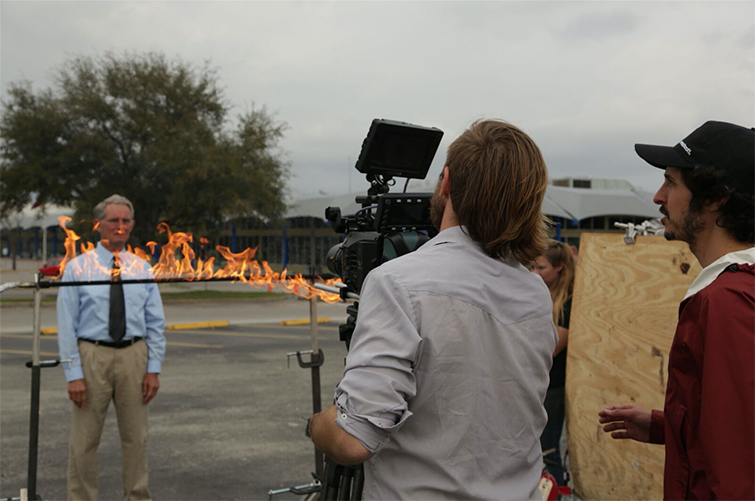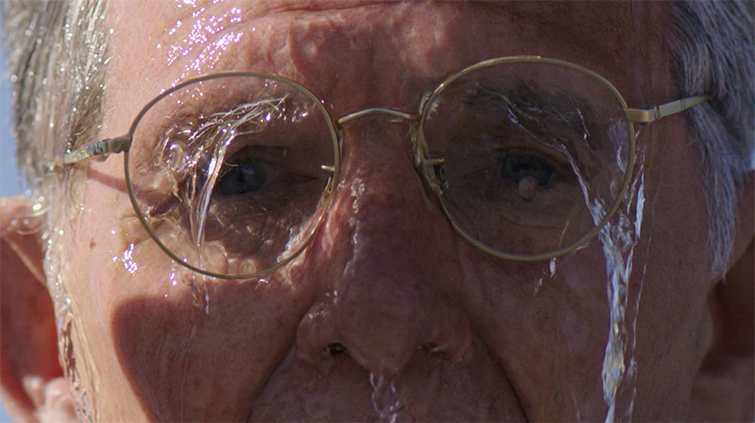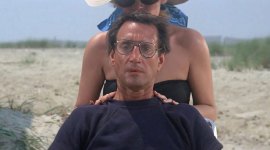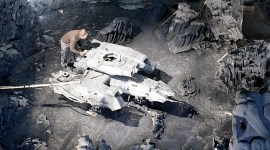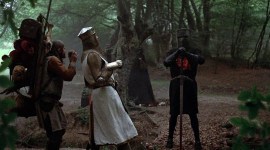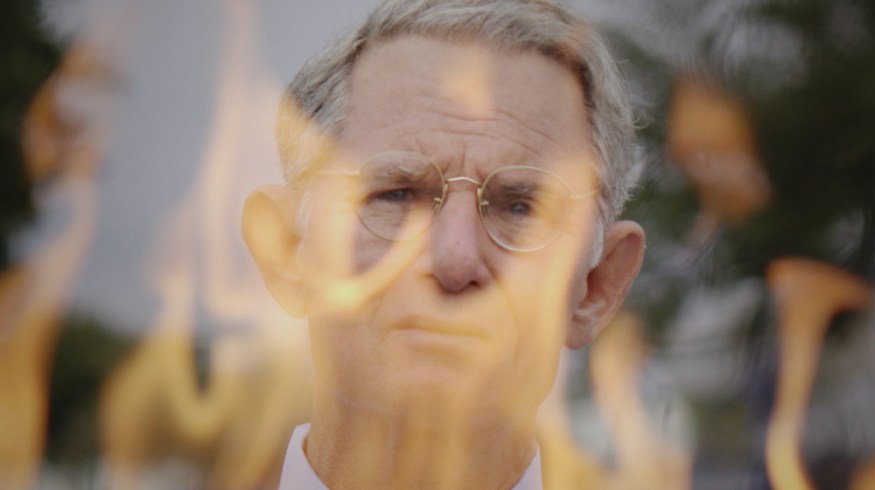
Interview: The Director and The Producer Behind “Man on Fire”
In 2014, a preacher in Grand Saline, Texas self-immolated to protest racism in his town. We talked with the filmmakers who captured his story.
All images via Joel Fendelman.
At this year’s Slamdance Film Festival in Park City, Utah, Man on Fire debuted as an official documentary feature. This film tells the story of Charles Moore, the Texas preacher who set himself on fire to protest the dark history of racism in his town. We sat down with director Joel Fendelman and producer James Chase Sanchez to talk about the challenges of capturing this story and what motivated them to bring it to the world.
PremiumBeat: Joel, tell me what drew your interest to this project?
Joel Fendelman: At the time I was working towards my MFA degree in the Radio, Television, Film program at the University of Texas, Austin. Chase and I had a mutual friend Kristen Lacefield who told me about Chase’s research and the story of Charles Moore. I was immediately taken back by the extreme act and that I had never heard about it. In fact, I had just arrived in Austin about a month after Charles self-immolated in Grand Saline. I remember especially at that moment having larger existential questions about purpose and my responsibility to social justice in society. And more specifically that I wasn’t doing enough. Whether it was going to a protest march or giving a few bucks to homeless person, it always felt like just enough to stave off the guilt. And here was a preacher who spent his whole life on a mission for social justice and felt that he had not done enough. So I was floored and in awe of this preacher who sacrificed his life in such a horrific manner for a social justice cause. So it attracted me on a deep personal level but also as in everything it wasn’t so black and white. There were many questions I had about Charles, about this town, about his choice. I knew immediately that this could be a good opportunity to explore these questions in a documentary that I would use as my final thesis project.
PB: Chase, tell us a bit about the research Joel mentioned. What were you working on, and why?
James Chase Sanchez: So I am an academic, and at the time of Moore’s self-immolation, I was in graduate school at Texas Christian University studying racial rhetorics (how people talk about race). On June 23, 2014, Moore self-immolated, and I started collecting news stories and talking with news organizations about this story to get it to the public. I went to my dissertation advisor and told him about Moore, and he suggested it should be my entire dissertation project. I framed my dissertation by talking about the recent uptick in self-immolations globally and then moving into the racial perceptions and folklore in Grand Saline. So by the time Joel got in touch with me about possibly making this documentary, I was already 2/3 through my project and had already interviewed 25 people.
I knew almost immediately when Moore self-immolated that if I ever had a story I needed to tell in my life this was it because I was raised in Grand Saline, and the racism that Moore wrote about was a racism I saw in the early-2000s. When his story didn’t make national news, I was upset because I couldn’t understand how something so powerful, something so visceral, didn’t get as much attention as self-immolations that take place in other parts of the world, like Tunisia and Tibet. So I jumped into my dissertation wanting to do justice by Moore, at least in an academic sense, and by extension, I believe this documentary does him justice, too.
PB: What gear did you use while shooting, and how big was your crew? Were there particular equipment challenges that you think were unique to this project?
JF: The documentary portion of the film was shot using a Sony A7sII with vintage Zeiss Contax lenses. In fact most of the footage was filmed using the 28mm. I used a Sony A6300 B camera for interviews and Ikan DS-1 gimbal for the floating shots. There were three of us: I ran camera, Chase did the interviews, and most of the location audio was done by Rodd Simonsen — with a few pick-up days by others when he couldn’t make it.
For the reenactment section, it was a full narrative-like crew. There were probably about 15-20 people over the three-day filming, and we used a Panasonic Varicam LT with Cooke mini S4 lenses.
One equipment challenge I had during interviews was that the A6300 B camera would overheat after about 20 minutes when filming in 4k. There were many times when I had stop the interview and cool off the camera. We eventually just ended up filming in 2k with that camera to avoid the overheating issue.
During the reenactment filming we brought on Big Dog Pyro to handle the pyrotechnics — who were fantastic to work with. We had a particular shot where we wanted the flames to encroach into the frame from either side. It was a challenge to figure where to position the camera and the flame bars. We ended up putting our cinematographer on the floor with the camera and the flame bars right above him and covering him with flame retardant blankets and filming at 240fps.
PB: Chase, I understand you faced some production challenges on this project. Particularly social challenges. Can you tell us about that? Did it ultimately benefit or damage the project?
JCS: Yes, since I grew up in the town, I found there to be some social challenges with the film. One of the first challenges is that there were many people who did not want to talk to me because they believed I had a liberal agenda I wanted to spread. I am an academic who studies race and rhetoric, and I have some radical thoughts when it comes to racial issues in America that I talk about publicly. Some town members believed the film was going to be used as propaganda against the town—that we would be claiming the town is racist and all the people in it are racist. So on that end, there were many people who would have been great to interview because they had some deep knowledge and stories about the town, but they chose not to share them with us. Also, I had a few friends who actually wanted to talk but felt they would be chastised by the town if they spoke, which is unfortunate. These challenges came to the forefront during our last trip to town, when we were asked not to attend the football game because it would be “better for us.” We were unsure if someone actually feared for our safety or if they just did not want us to attend the game.
Also, during this time, we learned from some prominent citizens in town that there were some people meeting and discussing our project and if they should speak with us or not. I am not sure if Joel agrees or not, but I felt that there were some people who spoke with us because they spoke with other people in town and got “permission” (in one way or another) to be interviewed. I think that was one of the challenges. I mostly felt people were honest with us on camera, but in some of the interviews, I had to press some people who I thought might be spinning stories.
Overall, I would say that my relationship to the town actually helped the project. I believe if outsiders came to town and tried to make this documentary, most of the town would have not responded. Michael Hall, the author of the “Man on Fire” article in Texas Monthly, which was one of the inspirations of the documentary, told me that he had a hard time getting anyone in town to discuss race with him. So while there were many people who did not speak because they knew me and believed we had an agenda, I still think my presence did make some people feel more comfortable because why would a former citizen who mostly enjoyed his adolescent years in town launch into a full-on assault of the town? I think we did a good job alleviating these problems by describing the nuance we were shooting for in the film, and I believe the final product is something that reflects this nuance.
PB: Joel, do you want to weigh in?
JF: It was interesting for me to observe Chase interacting with the townspeople, many who he had connection to directly or through family or friends. It was always a question whether the person knew Chase’s politics and if so how they felt about it. And then myself being a Jewish city boy, I was curious how that would come off. But interestingly enough, no one ever really asked. I’d say barring the experiences that Chase mentioned and some controversy on social media at the end, all the interviewees were pretty friendly and forthcoming. I did have a concern about how people would discuss race with us on camera and whether we could get anyone to really talk about it — similar to Michael Hall’s challenge. But the beauty of cinema in contrast to a written article is that the camera captures so much. So even when someone doesn’t want to answer a question or brushes it off, the visual act of not saying something can speak volumes. It kind of goes in line with the saying that a picture speaks a thousand words.
PB: Joel, you mentioned that you shot the documentary using vintage lenses, and we’re seeing more and more of this trend in the industry. As a cinematographer, what were you hoping to bring to your project with the particular load-out you carried on location?
JF: There are a number of reasons I decided to go with the vintage lenses. Firstly, digital can be very sharp and sterile, so any way that we can add character and slightly soften the edge of the digital image the better — unless one is going for the sharp, sterile look. Secondly, you can get pretty high-quality lenses for relatively cheap, at least compared to what a new lens of similar quality might cost.
As far as the equipment that I decided to use, it was based around a combination of price, aesthetic, and size. I love the look that the DSLRs are able to bring in such a small, reasonably priced package. At that point the Sony A7sII mirrorless camera had recently come out and was carrying a good reputation with quality and incredible low light capabilities. So it seemed like a good fit for this film because we wanted to be as low-key as possible and use natural light whenever available. It also allowed me to use the Ikan gimbal to create these very high-production-value, Steadicam-like shots for a fraction of the cost.
PB: Man on Fire was an official selection this year at Slamdance. What was your experience with the festival, and where can we look to watch the film?
JCS: Well, this was my first time at a film festival, so I was mesmerized by everything. Park City was full of people attending Sundance and Slamdance, and it was exciting to see so many creative people coming together to share their work with the world. For Slamdance especially, the mantra is “for filmmakers by filmmakers,” and you see that encompassed in the fabric of the festival. So many great independent filmmakers converged at this one festival, and the experience was very communal in nature. I was so happy to be a part of this project and to be able to experience this festival.
We have a few forthcoming screenings: we are screening at the Big Sky Film Festival in Missoula, Montana on February 17th, and we will also be in the San Luis Obispo Film Festival in March. We also have two upcoming school screenings at the Liberty Hall in Tyler, TX on February 28th at 6:00pm and at Texas Christian University on March 1st at 7:00pm. Finally, we will be a part of the PBS Independent Lens series either this fall or next spring.
JF: Let me add that one of the key motivating factors for us making this film was to use it as a vehicle for discussion and reflection. We have a link on our website, where you can request to host a screening and have us attend. So even if the film isn’t as of now scheduled to come to your town, it can be…
Looking for more filmmaking interviews? Check these out.
- Interview: How the Editor Behind I, Tonya Recreated History
- Interview: How This Oscar Nom Edited Downsizing While Directing His First Feature
- Exclusive Interview: The Secrets Behind RED Sensors and Resolution
- Interview: Reality T.V. Sound Mixer Matthew Hughes
- A Conversation with the DP of The Confession Tapes
Interested in more on working with vintage lenses? Read our previous coverage.


